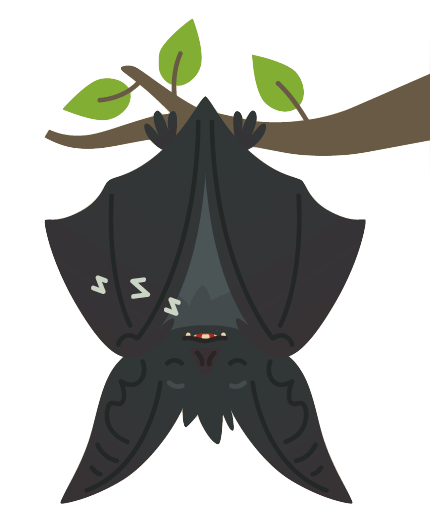
Prettyvectors, depositphotos.com.
by Heather McKee
WHOOSHoop. WHOOSHoop. WHOOSHoop.
It can sound like distant thunder, the ocean, metal flexing, or a bass drum. It’s the first sound mammals hear—a mother’s heartbeat pushing through the placenta. From there, the heartbeat becomes a metronome for life. Allegro. Excitement. Adagio. Relaxation.
We are familiar with our own variations in heartbeat, normally 60 to 100 beats per minute (bpm). But for other species in Montana, that range can be far wilder, particularly during the extremes of the seasons and the animal behavior associated with them.

Tinki V., depositphotos.com.
In the icy winters of Montana, when food and warmth are scarce, some animals descend into torpor, reducing their energy use through slowed metabolism and decreased body temperatures. There are a wide variety of states of torpor—some animals can descend involuntarily into a daily torpor, like bats and hummingbirds. On a cold night, a hummingbird’s heart rate may drop from more than 1,000bpm to only 50bpm.
Other animals descend into lengthier torpors in the coldest months, reducing their body temperatures to nearly the ambient temperature, and slowing their metabolisms to less than ten or even five percent of normal. These are the animals we call true hibernators. In general and worldwide, the larger the animal, the more capability there often is for hibernation.
You might think bears are examples of true hibernators, but even they have some surprises. Although we don’t share their ability to deeply rest, the bear’s heart is uncannily similar to ours.
WHOOSH. Bisecting the heart, the atrioventricular valves snap shut behind a blast of blood to the ventricles. oop. The smaller semilunar valves perched at the boundaries to the lungs and body swirl shut. WHOOSHoop. WHOOSHoop. WHOOSHoop.
If you were to rest your head on a bear’s chest and listen for a heartbeat while it was in hibernation (I wouldn’t; read on to find out why) you might wonder if it was still alive. Garrett Tovey, Citizen Science Specialist for Yellowstone Forever and former wildlife biologist for state and federal agencies, says Yellowstone National Park bear heart rates decrease from about 80-90bpm during active seasons to 8-19bpm during hibernation. Breathing slows to only a breath per minute.
Scientists in Yellowstone are beginning to believe bears may actually be “super hibernators”—named so for their ability to hibernate while keeping a fairly high body temperature. This means they can mobilize nearly instantaneously from lethargy—likely an adaptation to be able to protect winter-born young.
“A bear’s heart rate can increase from less than 10bpm to over 100bpm within seconds of being disturbed,” Tovey says. A rapid tempo change. “I’ve seen griz wake up and take over a wolf kill midwinter. It’s not a comatose state, more of a lethargic state.”

Happypictures, depositphotos.com.
Of course, you can also just simply freeze in winter. Boreal chorus frogs creep under logs and freeze solid—or nearly so. No heartbeat. No breathing. Dead? Alive? Dead? Alive? Exploring heartbeats and hibernation expands our concept of those two apparent poles.
Tovey explains that the chorus frogs increase the sugars in their blood by 200 percent to enter hibernation. These frogs reduce the water in their cells and organs to prevent bursting when the temperatures drop below freezing, then mobilize glycogen from their livers to flood their blood with simple sugars. This glucose reduces the freezing point of the fluids inside their cells and organs, and the water is directed to pockets under the skin to freeze.
Butterflies, too, use the sugar trick. Insects do not have blood, per se. But their bodies are filled with a nutritious slush, called hemolymph, that swirls nutrients around inside their bodies, propelled by multiple tiny, rudimentary hearts. So, behind a wedge of bark, adult butterflies like the delicate Milbert’s tortoiseshell can survive through winter with their hemolymph flooded with glucose.
So, do any animals actually fit our standard definition of a true hibernator? The ground squirrels and bats of Montana do—experiencing the reduced metabolism and drastically lowered body temperature of torpor for extended periods of time. A ground squirrel’s heart rate may drop from 400bpm to just five or six during its hibernation, and its body temperature can dwindle to nearly freezing. Its waking process can take hours.
With no fresh green grass and few of their predators hibernating, simply being mostly dormant and hidden under the snow can increase an animal’s life expectancy by five times that of non-hibernators in winter. Many tiny rodents are not as lucky as the ground squirrel, and must remain active under the snow through winter, leaping through snow-insulated tunnels to their larders.
Many animals migrate, transform, or eke out a hard living in barren Montana winters, and many of them don’t survive—their bodies and hearts freezing into the snow and becoming food for the survivors.
Despite the paucity of winter, surprisingly few animals actually hibernate in Montana. The truth is that significant anatomical adaptations have to happen for an animal to opt out of winter. From sugar-loading in butterflies to metabolic recycling in black bears, the ability to be active in only the productive months of the Rocky Mountains is complicated, specialized, and valuable.
Children’s picture books show animals tucking blankets around themselves, looking forward to a long winter’s nap, but in real, wild life, hibernation is a stark and essential survival technique with little padding or room for error. A bat that is woken up only once during its hibernation can lose precious fat reserves and starve over the remaining months.
But it’s spring now. The winter is nearly behind all of us. Bears and their new cubs are blinking at the cracks of bright light seeping into their dens, rays of light are slipping behind bark where butterflies are hidden, and slow warmth is thawing the detritus where chorus frogs are sequestered. Ground squirrels are furiously shivering to kickstart their hearts.
It is time to be active again.
WHOOSHoop. WHOOSHoop. WHOOSHoop.
Heather McKee is a science communicator and educator working as the Content Creator at Ecology Project International in Missoula, Montana. She has an M.S. in Environmental Studies from the University of Montana and is a Certified Interpretive Guide through the National Association of Interpreters.
This article was originally published in the Spring/Summer 2020 issue of Montana Naturalist magazine, and may not be reproduced in part or in whole without the written consent of the Montana Natural History Center. ©2020 The Montana Natural History Center.
Click here to read more articles from Montana Naturalist magazine.
Want to learn more about our programs? Sign up for our e-newsletter! You can also become a member and get discounts on our programs as well as free reciprocal admission to 300+ science centers in North America!











